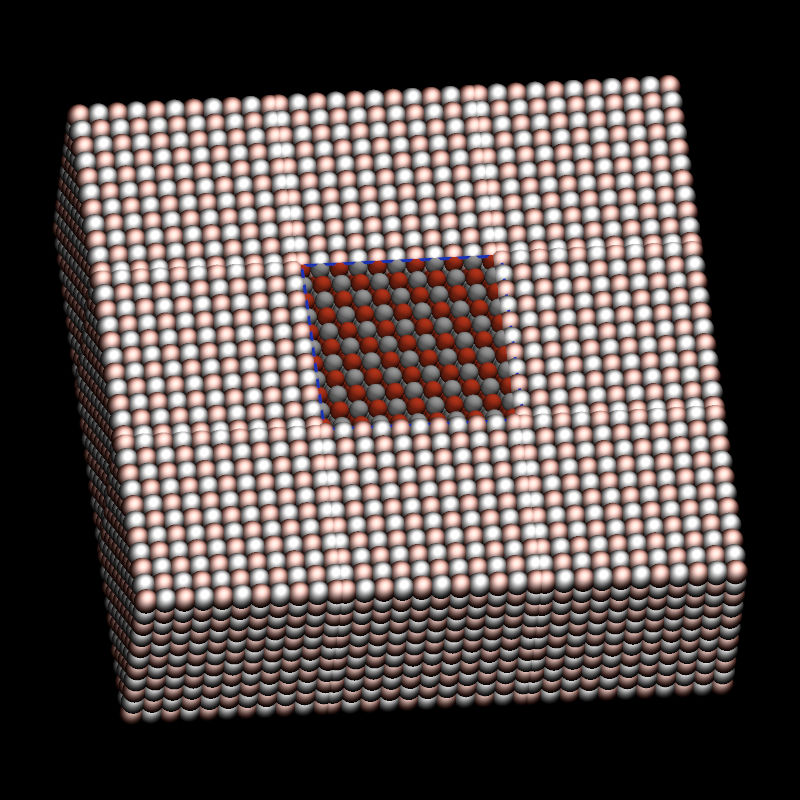Dear all,
dear sara,
I have been struggling with an issue for some while and I was wondering of
you could please help me,
I have been applying a finite strain to an MgO single crystal structure
using the xyz file attached and the box I'm applying to starts with 30A
length but seems to explode after that. Do you know why this is happening or
what I need to do to prevent it? The first two line of the log file looks
if your simulation is misbehaving, then you can
almost always expect that you have done some
wrong. only occasionally, you may run into a bug,
and it is even less likely that you have stumbled
over some interesting and new science.
with that in mind, it is always a good idea to visually
double check your input. just visualizing the attached
data file shows, that there is something _fundamentally_
wrong: when setting up an ionic crystal with periodic
boundary conditions, you cannot have identical elements
on the faces and corners. this is the reason why you
get such high pressure and energy and then your system
"explodes" (as it should).
on top of that, you have overlapping atoms, which is not
really helping much. please have a look at the attached
image that highlights the problem by showing your principal
simulation cell surrounded by its periodic copies in two
dimensions.
like this. I have attached the script, log file and MgO xyz file for your
reference.
Step Temp TotEng Pxx Pyy Pzz
Pxy Pxz Pyz Lx
Ly Lz
0 0 1959.4485 259813.66 259813.66 259813.66
23.101943 23.101943 23.101943 30.5 30.5 30.5
actually, the script does _not_ match the output here.
in fact, the data file doesn't even read correctly due to
some excess and misformatted lines.
in general, you cannot expect people here to do _your_
work for you and debug your input unless you have
some kind of proof that there is a bug in the lammps code.
in that case, however, you should also explain how to run
your input (e.g. if one has to use the -var switch and how).
just keep in mind that nobody here can read your mind and
thus you would have to make it as easy as possible for
people to reproduce your problem in order to get useful
help. providing files is good, but each obstacle in running
them will reduce the chances, that somebody will give them
a try.
46 0 \-0\.055172576 \-4\.9390244e\-07 \-4\.933589e\-07
-4.9324378e-07 3.0135869e-09 3.0135869e-09 3.0135869e-09 100.48519
100.48519 100.48519
In another also tried to define the MgO structure using the custom lattice
command but the results are not yet what I expect
so what _would_ you expect and what do you get instead?
again, if you want help, you have to make it easy to help and
spell it out where the problem is instead of letting people guess.
units metal
atom_style atomic
boundary p p p
lattice custom 4.212 a1 0.0 0.5 0.5 a2 0.5 0.0 0.5 a3 0.5 0.5 0.0 &
basis 0.0 0.0 0.0 basis 0.5 0.5 0.5
region box prism 0 2 0 2 0 2 0.0 0.0 0.0
create_box 2 box
create_atoms 2 box
mass 1 16
mass 2 24.035
I would appreciate help on this very much as I am in urgent need for the
results
a final remark: whether you need your urgently or not,
is primarily your concern, not ours. stating this in a request
for help, is another item that will - in general - lower the
chances to get (good) help. it would make sense, if you
would have a service contract, but the opposite is the
case, people volunteer their time and pointing out your
urgency without providing any incentive beyond that
to help you, only reminds people that they all have
urgent projects. 
cheers,
axel.



